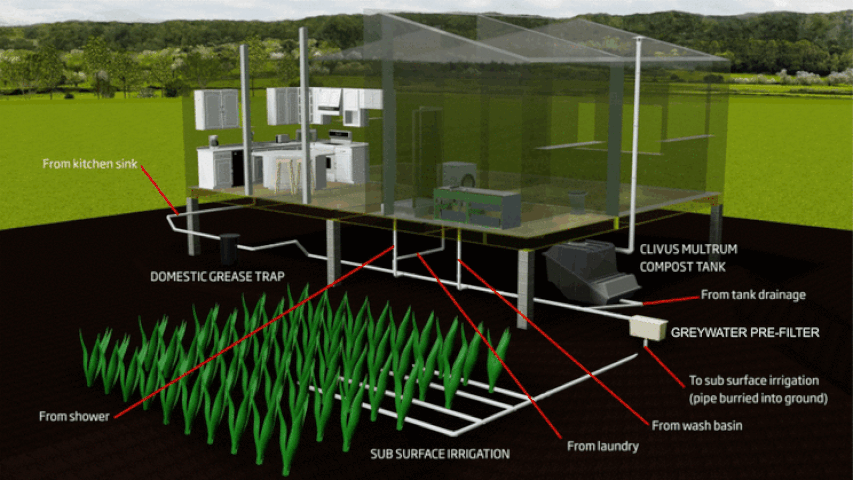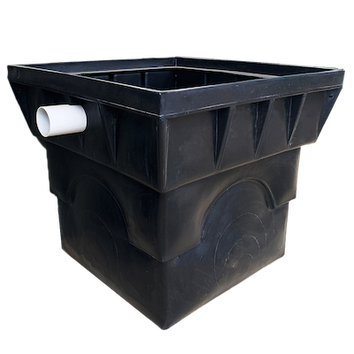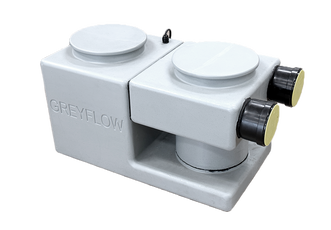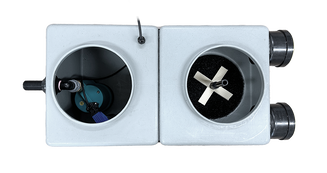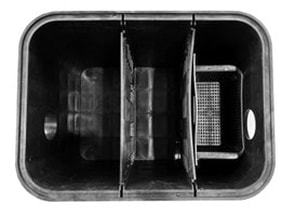|
If you have a waterless toilet, you often don't need a large, expensive treatment system for greywater.
The basic objective is to get the greywater out of the house and into the ground. Simple. |
Over the past 35 years, VIROtech has developed guidelines to help you build a simple, inexpensive greywater system which councils are increasingly willing to approve, although some council officers are reluctant due to the complex nature of the regulations.
|
|
Greywater systems are very site-specific and must be designed to suit your household, location and climate, but it could be as simple as a grease trap and some perforated pipe buried below the surface.
When you are not flushing toilets, the effluent from your household is different. The volume is reduced by 35% and the biological oxygen demand (BOD) decreases by up to 70%, so the effluent management is much simpler. The basic principles in dealing with greywater are:
In some cases it could be used to water trees and shrubs via sub-soil irrigation, but not for your vegetable garden. |
Your council will normally require you to submit an 'Onsite Sewerage Management System' (OSMS) application for your household. The application is more likely to be approved if prepared by a suitably qualified geo-technical engineer, so we suggest you engage a local geo-tech who has experience with your landscape and your local council.
Some geo-techs work from templates and may assume you will have flushing toilets, so make sure you tell them you don't. Find a geo-tech willing to design a system suitable for your particular household, and feel free to put them in touch with VIROtech if they have any questions. Above ground irrigation systems (drippers, sprinklers, etc) are rarely approved by local councils in the eastern states without tertiary level treatment, which usually involves expensive infrastructure. If your local council is reluctant to approve your system, VIROtech is happy to contact them on your behalf, but please remember not all sites are suitable for a simple greywater system. |
This is a typical system design using standard plumbing fittings, but only appropriate if the block is suitable.
Greywater Systems
|
We have two greywater systems available, but these should only be installed with local government, EPA or local health authority approval. A dripper system is normally just one part of a larger greywater system.
|
Drip irrigation systems are normally installed alongside an alternative sub-soil disposal area/leach field capable of taking all the greywater in wet weather. Ask VIROtech for reliable advice on how to approach the approval process.
|
|
FAMILY HOUSEHOLD - gravity fed pre-filter
Comprises an 80lt grease trap, 450lt Nature Clear passive gravity fed greywater pre-filter, 50m of tube, 100m of dripline, punch tool and fittings. The Nature Clear pre-filter is a direct inline sand and gravel filter designed to remove fine particles from the greywater before it enters the dripline and/or leach field. |
SMALL HOUSEHOLD - 240V pump driven diversion device
Comprises an 80lt grease trap, GREYFLOW greywater diversion device with 50lt buffer tank, 50m of tube, 100m of dripline, punch tool and fittings. The GREYFLOW is designed to divert greywater to an irrigation system and send excess effluent to an alternative high capacity leach field. |
Greywater System Components
Nature Clear Greywater Pre-Filter
|
The filtration tank, which is less than 1 cubic meter in size, consists of a pine bark coarse filter on top of different grades of sand and gravel. The filter cloth is provided but due to freight costs the sand and gravel should be sourced locally. Sample bags of these are provided with the system to assist with your selection of the correct grade materials.
The pine bark traps large particles not caught in the grease trap plus lint from the washing machine. The sand filter catches still finer materials, polishes the water and reduces the organic content of the water. The pine bark is separated from the sand by filter cloth. The filtered material and bark will compost over time and should be removed every twelve months and replaced with fresh bark, available from your local garden nursery. The improved condition of the greywater will extend the life of your effluent disposal area (EDA) - in other words you can dispose of your greywater in the same place for longer. |
GREYFLOW Greywater Pre-filter/Diverter
|
Developed in Australia, the GREYFLOW greywater pre-filter/diverter is a simple, low profile and reliable component designed to improve the quality of water before it is reintroduced to the landscape. Its compact design makes it easy to install on a wall, on the ground or partially buried. It utilises an extra-large filtration, sludge trap and a robust thermal protected 240V pump to send greywater to an irrigation system, and has an overflow outlet which directs effluent to the alternate system when the irrigation system is not in use*. *Irrigation systems are designed to disperse greywater to gardens, but may not meet council requirements unless an approved alternative disposal system is also available to take the greywater - for instance when it is raining. |
Grease Trap
|
Greasetraps separate the grease, oil and excess food stuffs from the greywater.
When the outflow from your kitchen sink enters the grease trap, the solid food particles sink to the bottom, while they lighter grease and oils float to the top. They are an integral part of an effective greywater system and should be cleaned periodically. |
Rotor Valve Diverter
|
Some greywater systems may work better if the effluent is not directed to one area but dispersed across multiple areas. Our greywater flow-diverter automatically rotates supply to up to 6 separate areas as required.
This is sometimes useful when the area required to disperse all your greywater is not available at one location, or where you'd like to direct some of it to specific sites - e.g. orchards or gardens. The valve is flow activated and can operate with as little as one metre of head. The hydraulic operation means no external power is required.
|



